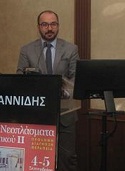
Dr. Orestis Ioannidis
General Hospital "George Papanikolaou", Greece
Title: Open abdomen and negative pressure wound therapy for acute peritonitis especially in the presence of anastomoses and ostomies
Abstract:
Acute peritonitis is a
relatively common intra-abdominal infection that a general surgeon will have to
manage many times in his surgical carrier. Usually it is a secondary
peritonitis caused either by direct peritoneal invasion from an inflamed
infected viscera or by gastrointestinal tract integrity loss. The mainstay of
treatment is source control of the infection which is in most cases surgical.
In the physiologically deranged patient there is indication for source control
surgery in order to restore the patient’s physiology and not the patient
anatomy utilizing a step approach and allowing the patient to resuscitate in
the intensive care unit. In such cases there is a clear indication for
relaparotomy and the most common strategy applied is open abdomen. In the open
abdomen technique the fascial edges are not approximated and a temporarily
closure technique is used. In such cases the negative pressure wound therapy
seems to be the most favourable technique, as especially in combination with
fascial traction either by sutures or by mesh gives the best results regarding
delayed definite fascial closure, and morbidity and mortality. In our surgical
practice we utilize in most cases the use of negative pressure wound therapy
with a temporary mesh placement. In the initial laparotomy the mesh is placed
to approximate the fascial edges as much as possible without whoever causing
abdominal hypertension and in every relaparotomy the mesh is divided in the
middle and, after the end of the relaparotomy and dressing change, is
approximated as much as possible in order for the fascial edges to be further
approximated. In every relaparotomy the mesh is further reduced to finally
allow definite closure of the aponeurosis. In the presence of ostomies the
negative pressure wound therapy can be applied as usual taking care just to
place the dressing around the stoma and the negative pressure can be the
standard of -125 mmHg. However, in the presence of anastomosis the available
date are scarce and the possible strategies are to differ the anastomosis for
the relaparotomy with definitive closure and no further need of negative
pressure wound therapy, to low the pressure to -25 mmHg in order to protect the
anastomosis and to place the anastomosis with omentum in order to avoid direct
contact to the dressing. The objective should be early closure, within 7 days,
of the open abdomen to reduce mortality and complications.
Biography:
Dr. Ioannidis studied
medicine in the Aristotle University of Thessaloniki and graduated at 2005. He
received his MSC in “Medical Research Methodology” in 2008 from Aristotle
University of Thessaloniki and in “Surgery of Liver, Biliary Tree and Pancreas”
from the Democritus University of Thrace in 2016. He received his PhD degree in
2014 from the Aristotle University of Thessaloniki for his thesis “The effect
of combined administration of omega-3 and omega-6 fatty acids in ulcerative
colitis. Experimental study in rats.” He is a General Surgeon with special
interest in laparoscopic surgery and surgical oncology and also in surgical
infections, acute care surgery, nutrition and ERAS. He has received fellowships
for EAES, ESSO, EPC, ESCP and ACS and has published more than 130 articles with
more than 3000 citations and an H-index of 28